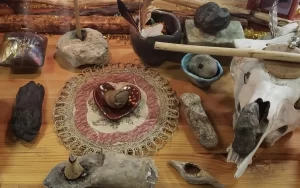I am very familiar with healing co-dependence as it is one of the core issues I needed to address in my life. Looking back at my old diaries, I see that my life was rife with co-dependence. I didn’t have a name for it until recently. I believe co-dependence is a learned survival strategy, usually mastered in childhood. When we give others what we think they need, we think we will be safer and that we get love in return.
When parents and care-givers are wounded and their family systems dysfunctional, they are less able to be healthy mirrors to their children. Instead, they unconsciously ask their children to be mirrors for them and to retain the status quo of the family system, no matter what. The system and the wounded-ness dominate and the true developmental needs of the child are not given importance.
“Co-dependence is a behavioral condition in a relationship where one person enables another person’s addiction, poor mental health, immaturity, irresponsibility, or under-achievement. Among the core characteristics of co-dependence is an excessive reliance on other people for approval and a sense of identity.” [from wikipedia]
Over time, if a child’s needs and identity are never mirrored back to them and they are only given approval when they support the needs of others, they internalize the information that they only exist in relation to others. The positive feedback they get from their principal caretakers becomes their lifeline to feeling ‘alive’ and they will do anything to get this feeling. They only receive crumbs of acknowledgement from a system of relating that demands all their energy and a lot of self denial.
This form of relating eventually teaches the child that he/she only exists in relation to others. If others approve of them, if the people around them are ‘happy’, then they exist. If not, their sense of self crumbles and they feel like they will die.
Marion Woodman talks about the ‘Death Mother’, an archetype that we don’t like to look at because a ‘mother’ is supposed to be always nurturing, kind and loving. The Death Mother, on the other hand, is only capable of seeing her child in terms of how he or she can serve her. If she doesn’t like the way the child is, she gives her ‘the look that turns her to stone’. The child learns that she has to be perfect in her mother’s eyes to be loved. She becomes addicted to perfection as Marion Woodman says and full of rage. Deep down she recognizes that she is not loved for who she is, but for who her mother wants her to be. You can read more about the Death Mother here.
As the child grows up and goes into the world, this way of relating to others permeates all their relationships. A true co-dependent relates to everyone in this way.
A deep fear of annihilation lies behind this pattern of relating and, as stated above when talking about the Death Mother, the mother is at the heart of most c-odependence. Our relationship with her is our first and foremost relationship with another. It is with her we learn how to relate. The mother also takes into account the mother line. We inherit much of how we mother through the mother line. It is passed down subliminally. We are mothered by the mothers that were mothered by their mothers and so forth. Co-dependency could very well be something that has been passed down ancestrally for generations. Can you see codependent relating coming down your bloodline?
When we are co-dependent, we give ourselves away. We never knew or forgot what it is like to think and express our own needs. We always express what we think others want to hear, rather than standing in our own truth. We think about leaving our narcissistic partners, but feel the world drop beneath our feet when we imagine being alone or just saying the words ‘I need to live my own life’ and following through.
Florian tells a joke about the definition of a person with co-dependence: When they are on their deathbed they see someone else’s life flash in front of their eyes.
This may be a joke, but it is very true. Our first and foremost belief is “we will only be loved if we become what the other wants us to be.” Some of us may find ourselves some years into a relationship and our partner cannot understand that we are angry and resentful because we do not feel seen. And yet, how can we even imagine that we will be seen when we built this relationship on co-dependence.
There is a magnetic attraction between co-dependents and narcissists, which is described in Ross Rosenberg’s book “The Human Magnet Syndrome.” The co-dependent needs someone to curtail to, someone who needs them to give their life away to in the way they gave their lives away to their mothers. A narcissist is the ideal partner. The nature of the narcissist is that he believes that he is the center of the world, no one else matters except how they can serve the narcissist. The co-dependent has severe difficulty with boundaries and doesn’t know where the other begins and ends in relation to herself. She also has extremely low self esteem and feels she is responsible for taking care of others’ problems. Particularly with partners, she will make excuses for their unacceptable behaviours, while supporting and even enabling them. The two make perfect partners because their dysfunctionality is completely compatible.
Steps to Heal Co-dependence
1. Turn the perspective inwards and learn to love yourself.
People with co-dependence, as we have seen, ignore their own existence. They only exist in relation to others. One of the first and most important steps to change this is to bring the regard inwards. Instead of always looking outwards to others and wanting others to approve and acknowledge us, there is a great need to learn self-esteem through attending to our own needs, feelings, desires, thoughts, and beliefs, before anyone else. This isn’t selfish or egoic! It is re-learning that we exist in our own right and that we need to listen to and acknowledge ourselves before we turn our attention to others. At first it feels strange. We are so unfamiliar with existing in our own right, that putting ourselves first needs some getting used to. This change in perspective means that we start to take responsibility for our own lives, prioritize self care and get to know ourselves, instead of always feeling responsible for other adults’ lives.
Flower Essences and Essential Oils to support us in this work
Patience with ourselves and support from friends, therapists and plant medicine can all be helpful as we reprogram ourselves.
Love Thyself is a blend made up from 6 single flower essences to make a potent blend that helps us to learn to love and parent ourselves. When reprogramming yourself to turn inwards and put yourself first, it can be a great ally.
Angelica Root and Angelica Seed Essential Oils: I usually use these two oils together and they are absolutely amazing. Angelica opens the inner space, the deep place in which the Self resides and where we encounter ourselves. It helps us to remember that this is the starting place, the inner home. In co-dependence, we are often taken over by the exterior—other people’s expectations, other people’s problems, other people’s demands, etc. Angelica reminds us to seat ourselves within ourselves before we deal with these outer aspects of life. These two oils re-establish the right relationship between the exterior and the interior. Angelica root grounds us and angelica seed invites us to open up to the world of inspiration. Together they bring the celestial realms down into the body through the heart and into the embodied self. They reveal a beautiful harmonic dance of base, middle and top notes of the Self. These oils have really helped me center myself within and feel the support of being fully embodied, while at the same time sensing the expansion of all aspects of myself as they connect with the whole. These oils really connect and ground our spirit and our bodies, enabling us to integrate life’s experiences and move forward through the tasks that life proposes. I love the way that it brings the spirit or the soul into the body, where we can integrate the outer influences, rather than allowing them to dominate.
Exercise
Using the angelica oils or other oils of your choice, that help you come into this central place within, I invite you to reflect and journal on the following questions.
- Tune into yourself. How do you feel? Where is the energy in your body? What is your soul saying to you?
- What do you need at the moment? How are you going to give it to yourself?
- What do you want at the moment? Is it reasonable and if so, how do you plan to accomplish this desire?
- What are your core beliefs?
- What do you like about yourself? Find a positive affirmation that helps you love and respect yourself and say it regularly throughout the day. For example, “Today I choose me”.
- How do you deserve to be treated? How are you going to start to treat yourself in this way? Name one thing everyday this week that concentrates on treating yourself lovingly.
- What do you like doing?
- Where would you like to have accomplished for yourself in three months time?
2. Setting Healthy Boundaries
As you start to turn your regard inwards and concentrate on your own needs, you may discover that your boundaries are flimsy. You may feel other people coming into your thoughts or your space and demanding energy from you. You may even be afraid of certain people’s reactions if you don’t put them first anymore. All these things show that you need to work on boundaries.
Flower Essences and Essential oils to support us in this work
Safe Boundaries is a blend of five single flower essences to help you to create personal space around you so that your boundaries are healthy.
Yarrow Essential Oil is the master of healthy and strong boundaries. I recommend you begin your day by putting a drop between the palms of your hands and rubbing them together before directing the aromatic molecules around you. You can watch how to do this in this video we recorded about yarrow.
Exercise – Cutting the Ties that Bind
We have used this exercise that originates from the work of Krystal Phyllis with many of our clients who feel they need to create healthy boundaries between themselves and certain people in their lives, often parents. We have also used it ourselves and can vouch for its power to help redefine who we share our energy with and how. We often notice that when someone gets into this exercise, the person they are trying to cut ties with will ring up or ask them to do something for them. They feel energetically that something is shifting and try to draw the relationship back to how it was. Beware of this and do not fall into that trap! I advise you to use yarrow essential oil during the period that you do the exercise, which generally lasts around two weeks.
1. Take two pieces of paper and draw a circle on each with a yellow or golden felt tip that symbolizes light.
2. Put your name in one circle and the name of the other person in the second circle. Tune into the soul of the person you are doing the exercise with and let them know that you are doing this in order to benefit your relationship and so that you can take responsibility for your own shadow rather than making them carry it. If a child is doing it regarding a parent, they can tune into the soul of the parent and let them know that they can no longer carry what is not theirs and they are doing this exercise in order to put things back in their rightful place. Please note this exercise can be done with living and deceased relations.
3. Put the two pieces of paper on an altar space or somewhere where they can stay and not be disturbed for up to a couple of weeks. The two pieces of paper can touch on one side.
4. Every time you think about this exercise, as you are going through your day, you visualize yourself and the other person in their own circle with light defining it. As you visualize this you say, “What belongs to you, you keep, what belongs to me I keep.” Do this multiple times per day. At the end of every day move the circles slightly further apart. If the other person tries to get into your circle, firmly visualize them back in their own.
5. After some days, it can be up to two weeks or so, you will feel that the work has been done. When you are sure about this, tune into the circles and as you move them away from each other for the last time, visualize cutting any ties from your shadow to your child’s or from your parents’ to yours (depending on who is doing the exercise).
6. You can then compost or burn the circles.
I would like to tie up this article with a few threads related to women’s inner work during the transition from peri- to post-menopause. Marion Woodman talked about reclaiming the virgin during menopause. We go back and consciously integrate our child into who we are becoming. Our virgin or child self was true to herself and expressed her creative self from source. Often life’s experiences and responsibilities distanced us from this free, creative being we all were born with. The invitation at menopause to bring her back consciously into our lives is a powerful one and relates to the triple goddess, we become the virgin, the mother and the crone – all in one. However, those of us that have suffered from codependency, where pleasing others is the only form of existence we know, need to go back and get the wounded child we abandoned. She was abandoned when it became too dangerous to listen to her. Instead we learnt to survive, we became people pleasers.
Part of the consulting work that Florian and I do involves leading people back to their childhood homes to go and retrieve that part of themselves they left behind. She then becomes the most important relationship in our lives. We promise never to abandon her again. We will always listen to her needs, thoughts, wisdom etc. It is always a powerful yet beautiful experience retrieving that lost part of ourselves so we can heal and become whole. The oil we commonly use for this work is Rose Attar. In this attar, the gentle, soft smell of roses is cradled by the underlying notes of the sandalwood. It is intoxicating and nurturing, like coming home into the warmth after being caught in a storm. It is the sweetness so many of us are searching for. It makes you feel loved, held and understood. The rose sings and opens the heart, while the sandalwood provides a safe, warm, woody ground for this purring aroma. Its soft vibration is instant, embracing the skin, bringing a smile to the face. It provides a feeling of safety, unlike any other aroma. Its smell allows you to let go and fall into it, like a baby being cradled in a mother’s arms. Rose Attar is used to help ‘cool’ excess heat, open the heart doorway and regulate hormonal imbalances.
“A life truly lived constantly burns away veils of illusion, burns away what is no longer relevant , gradually reveals our essence, until at last, we are strong enough to stand in our naked truth”. Marion Woodman
share this blog:
Recent Posts
Archives
- December 2023
- November 2023
- September 2022
- July 2022
- September 2021
- August 2021
- July 2021
- June 2021
- April 2021
- March 2021
- February 2021
- January 2021
- November 2020
- October 2020
- August 2020
- July 2020
- June 2020
- May 2020
- April 2020
- March 2020
- February 2020
- October 2019
- September 2019
- July 2019
- May 2019
- March 2019
- September 2018





